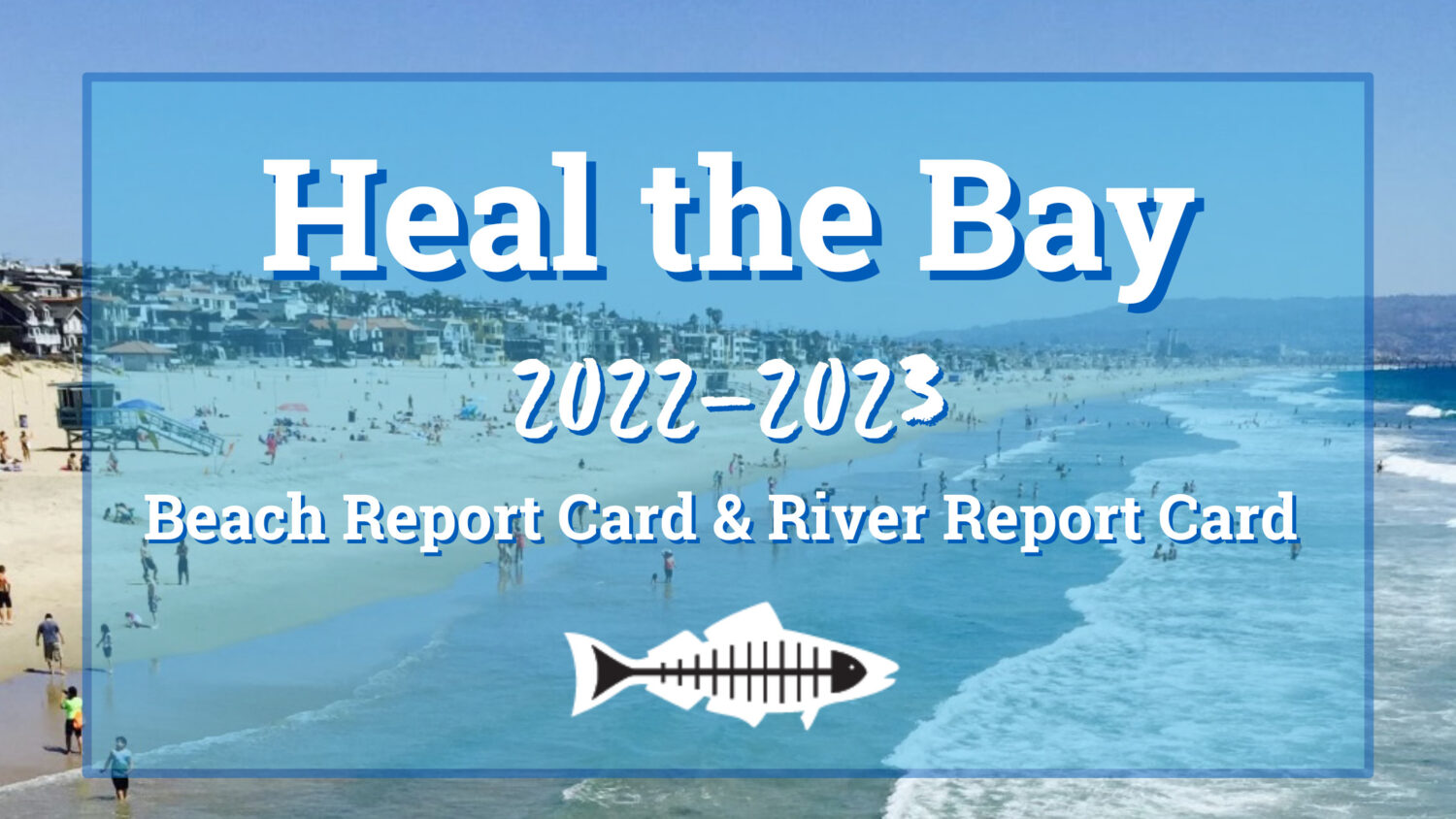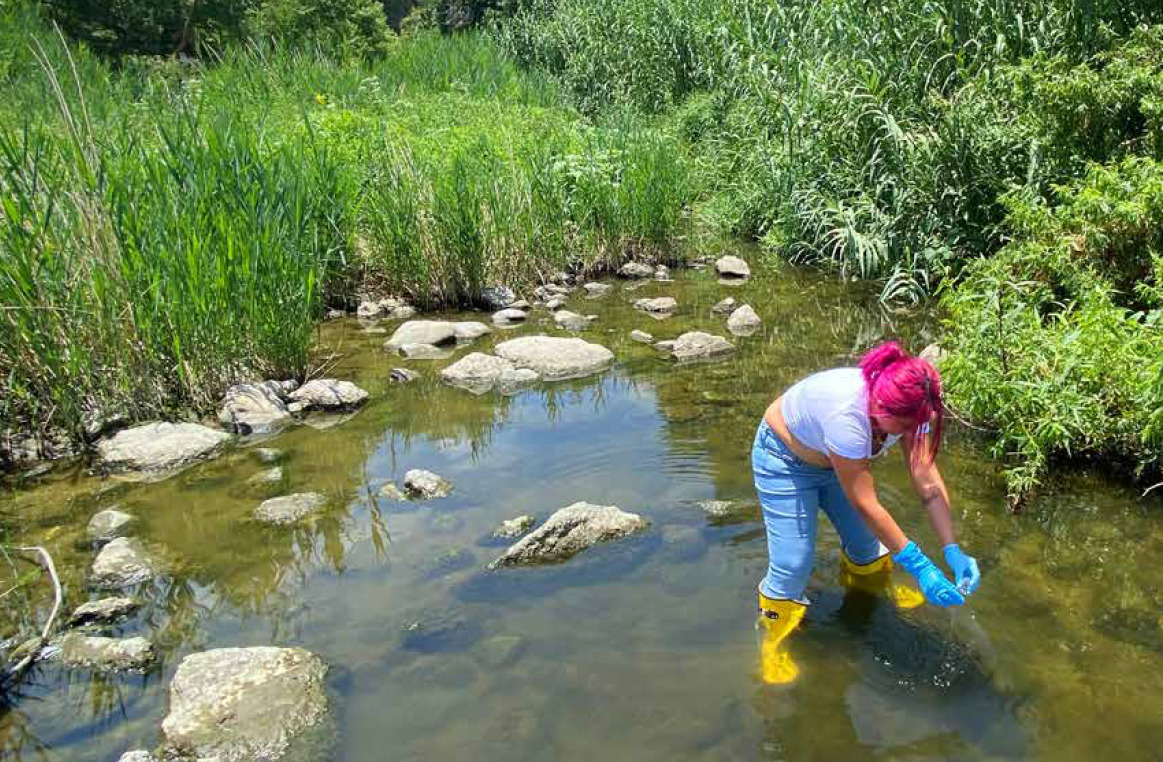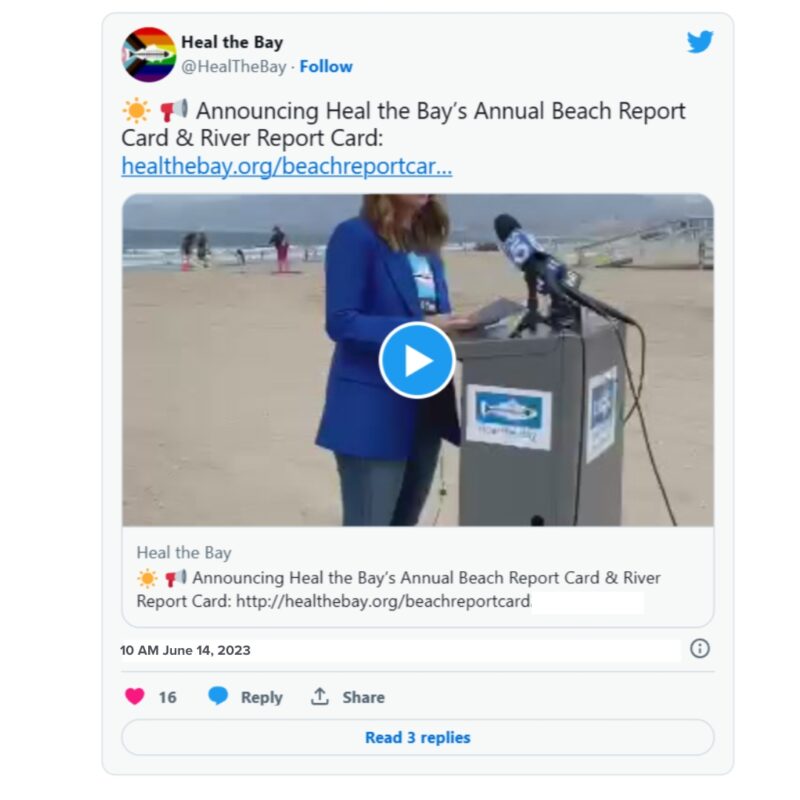Heal the Bay Releases Annual Beach Report Card & River Report Card 2022-2023

Summer is officially here – the peak season for swimming outdoors. Heal the Bay releases its annual scientific reports on bacterial-pollution rankings for hundreds of beaches in California and dozens of freshwater recreation areas in Los Angeles County.
SUMMARY
For more than 30 years, Heal the Bay has assigned annual “A-to-F” letter grades for 700 beaches from Washington State to Tijuana, Mexico including 500 California beaches in the 2022-2023 report, based on levels of fecal-indicator bacterial pollution in the ocean measured by County health agencies. In addition, since 2017, the organization has ranked freshwater quality, releasing report grades for 35 freshwater recreation areas in Los Angeles County for summer 2022 in its fifth annual River Report Card. The public can check out the updated water quality of their local freshwater recreation areas at healthebay.org/riverreportcard and ocean beaches at beachreportcard.org or by downloading the app on their smartphone.
BEACH REPORT CARD HIGHLIGHTS

The good news is 95% of the California beaches assessed by Heal the Bay received an A or B grade during summer 2022, which is on par with the average.
Even so, Heal the Bay scientists remain deeply concerned about ocean water quality. Polluted waters pose a significant health risk to millions of people in California. People who come in contact with water with a C grade or lower are at a greater risk of contracting illnesses such as stomach flu, ear infections, upper respiratory infections, and rashes. Beaches and rivers usually have poor water quality following a rain event. More rain typically means that increased amounts of pollutants, including bacteria, are flushed through storm drains and rivers into the ocean. Sewage spills pose increased health risks and trigger immediate beach closures, which should be heeded until public officials clear the area. Last year an astounding 45 million gallons of sewage were spilled and made their way to California beaches. Only 56% of California beaches had good or excellent grades during wet weather, which was worse than average, and very concerning.
“As climate change continues to bring weather whiplash, our water woes will swing from scarcity to pollution. This year, record precipitation produced major impacts on water quality across Coastal California,” said Tracy Quinn, President and CEO of Heal the Bay. “Now more than ever, we must prioritize multi-benefit projects to manage stormwater as both a water quality and supply solution, all while ensuring that the public is kept informed of risks to public health.”
Heal the Bay’s Beach Report Card and River Report Card provide access to the latest water quality information and are a critical part of our science-based advocacy work in support of strong environmental policies that protect public health.
Read Beach Report Card summary en Español
BEACH BUMMER LIST
Heal the Bay’s Beach Bummer List ranks the most polluted beaches in California based on levels of harmful bacteria in the ocean. The 2022-2023 Beach Bummer List includes beaches in Los Angeles, San Mateo, San Diego, and Orange Counties as well as the Tijuana Area. This year, Santa Monica Pier and Playa Blanca in Tijuana tied for the top spot as both faced significant water quality challenges.
- 1-2. Playa Blanca, Tijuana Area
- 1-2. Santa Monica Pier, LA County
- 3. Linda Mar Beach, San Mateo County
- 4. Marlin Park, San Mateo County
- 5. Erckenbrack Park, San Mateo County
- 6. Tijuana River Mouth, San Diego County
- 7. Pillar Point Harbor, San Mateo County
- 8. Marina del Rey Mother’s Beach, LA County
- 9. Poche Beach, Orange County
- 10. Gull Park, San Mateo County
BEACH HONOR ROLL LIST
This year, only two out of over 500 monitored beaches made it on the Honor Roll compared to 51 last year. Unfortunately, the unprecedented amount of rain that fell across California during the 2022–2023 winter led to an enormous dip in water quality and a very short Honor Roll list. The Honor Roll is typically dominated by Southern California beaches, in part, because many Northern and Central California Counties do not monitor beach water quality year-round. However, it appears that the wet weather from this past winter took its toll everywhere.
- Point Loma, Lighthouse, San Diego
- Bean Hollow State Beach, San Mateo
The record rainfall impacted the Honor Roll list in two ways: 1) fewer beaches received Winter Dry Grades because most of the winter data was collected during wet weather, and 2) increased precipitation negatively impacts water quality. In order to get on the Honor Roll, a beach must have zero bacterial exceedances all year under all conditions, which is extremely difficult to do with so much rainfall. The unsettlingly short Honor Roll was also impacted by our inability to grade one third of San Diego County’s beaches, which usually comprise a large portion of the Honor Roll (15 in the last report). in 2022 San Diego agencies began using a new testing method for bacterial pollution at nearly a third of beaches in the County, which is unfortunately not yet compatible with our grading methods in the Beach Report Card. Find out why we couldn’t grade nearly a third of San Diego beaches in the full report.
RIVER REPORT CARD HIGHLIGHTS

Heal the Bay graded 35 freshwater recreation areas in Los Angeles County within the L.A. River, San Gabriel River, and Malibu Creek Watersheds during summer 2022. Across all 35 sites and all dates graded throughout summer 2022, 65% of grades were Green (indicating no water quality health risks); 15% were Yellow (moderate health risk), and 19% were Red (high health risk). This was an improvement from the previous year.
We are thrilled to be debuting a new method for grading freshwater quality in summer 2023 in our weekly grades that are online. The method was developed with the help of a team of water quality experts and will use the same letter grading system (A-F) as the Beach Report Card to improve user experience and reflect the latest science.
“Our River Report Card identifies a disturbing trend between development and water quality. The natural areas in our watersheds, rivers and streams with muddy or sandy bottoms and ample flora, typically have the best water quality and are the safest for the public. In contrast, heavily developed areas, waterways encased with concrete (including within the L.A. River channel) and stormdrain inputs, tend to have lower water quality. We recommend checking out the River Report Card before heading out to the L.A. River because bacteria levels are often at unsafe levels and you can find a safer spot for cooling off,” said Dr. Alison Xunyi Wu, Water Quality Data Specialist and co-author of the River Report Card and Beach Report Card.
Read River Report Card summary en Español
FRESHWATER FAILS LIST
Top 10 river recreation sites in Los Angeles County that are high-risk places to contact the water. Note: Three sites are tied for number 1 Freshwater Fails.
- 1-3. L.A. River at Riverfront Park
- 1-3. Compton Creek
- 1-3. Tujunga Wash at Hansen Dam
- 4. L.A. River below the Rio Hondo Confluence
- 5. L.A. River at Willow St.
- 6. L.A. River at Hollydale Park
- 7. L.A. River below the Compton Creek Confluence
- 8. Bull Creek
- 9. Lake Balboa Boat Ramp
- 10. Las Virgenes Creek
FRESHWATER HONOR ROLL LIST
Top 10 river recreation sites in Los Angeles County that are low-risk places to swim or boat. An impressive eight sites tied for number 1 with 100% Green grades all summer.
- 1-8. San Gabriel River East Fork at Graveyard Canyon
- 1-8. San Gabriel River Upper Cattle Canyon
- 1-8. Hansen Dam Lake
- 1-8. San Gabriel River Upper East Fork
- 1-8. San Gabriel River Upper West Fork
- 1-8. Big Tujunga Creek at Vogel Flats
- 1-8. Big Tujunga Creek at Delta Flats
- 1-8. San Gabriel River Lower West Fork
- 9. Eaton Canyon
- 10. San Gabriel River Upper North Fork
TIPS TO STAY SAFE AT OCEAN AND FRESHWATER AREAS
- View beachreportcard.org and healthebay.org/riverreportcard for the latest water quality information.
- Avoid shallow, enclosed beaches with poor water circulation.
- Swim at least 100 yards away from flowing storm drains, creeks, and piers.
- Stay out of the water for at least 72-hours after a rain event.
- Follow all local health and safety regulations, including all local pandemic-related regulations.
- Check in with the lifeguard or ranger on duty for more information about the best places to swim.
- Stay in the know! This year, the annual reports received state and national coverage – appearing in the New York Times, LA Times, and Associated Press.
ACCESS TO WATER RECREATION
The COVID-19 pandemic, record-setting wildfire seasons, and extreme heat have compounded the already dire need for equity in our recreational waters, and exposed major systemic failures; open spaces, including beaches and rivers, are not equally accessible to all people. Low-income communities of color tend to be the most burdened communities, bearing the brunt of environmental pollution, socioeconomic disparities, and limited access to safe, healthy, and clean water recreation. Heal the Bay is committed to expanding the user base of our Beach Report Card and River Report Card. We have started by working with local community-based organizations that are taking down barriers to water recreation for communities of color. Through this work, we will amplify what “safe, healthy, and clean access to water recreation” means in the communities where it is needed the most.
WATCH THE FULL 2022- 2023 PRESS CONFERENCE
About Heal the Bay: Heal the Bay is a 501(c)3 nonprofit organization founded in 1985. They use science, education, community action, and advocacy to fulfill their mission to protect coastal waters and watersheds in Southern California with a particular focus on public health, climate change, biodiversity, and environmental justice. Heal the Bay Aquarium, located at the Santa Monica Pier, welcomes 100,000 guests annually and hosts a variety of public programs and events that highlight local environmental issues and solutions. Learn more at healthebay.org and follow @healthebay on social media or watch this short video.
Beach Report Card with NowCast, in partnership with World Surf League, is Heal the Bay’s flagship scientific water quality monitoring program that started in the 1990s. For more than thirty years, the Beach Report Card has influenced the improvement of water quality by increasing monitoring efforts and helping to enact strong environmental and public health policies. Learn more at beachreportcard.org and download the free app on Apple and Android devices. The Beach Report Card is made possible through generous support from SIMA Environmental Fund, SONY Pictures Entertainment, and World Surf League.
About River Report Card: Currently, there is no statewide water quality monitoring mandate for rivers and streams in California, like exists for the ocean as a result of the Beach Report Card. Heal the Bay started the River Report Card in 2017 to push for new public health protections for freshwater areas in addition to serving the immediate need for increased public awareness about the risks at popular freshwater recreation areas in Los Angeles County. Learn more at healthebay.org/riverreportcard. The River Report Card is supported by Environment Now.
Download Press Release in English
View the Beach Report Card and River Report Card from last year.



